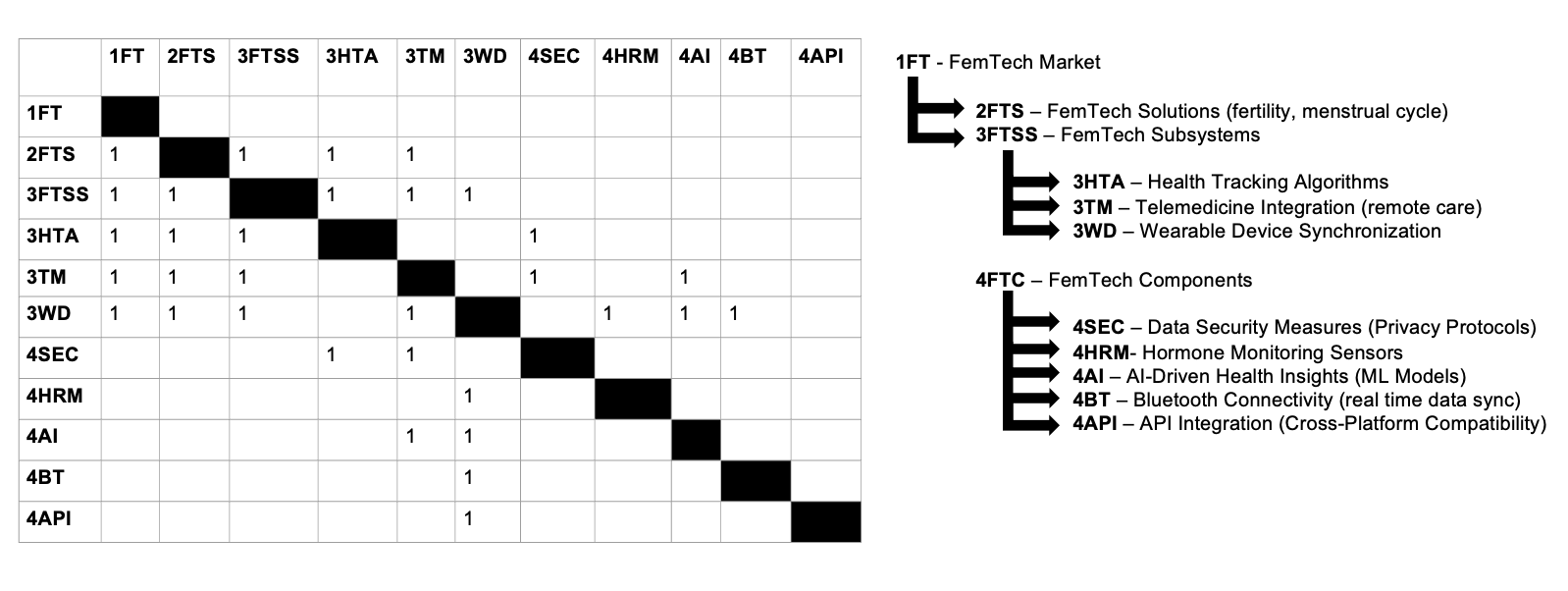Difference between revisions of "FemTech"
| Line 41: | Line 41: | ||
==Alignment with Company Strategic Drivers== | ==Alignment with Company Strategic Drivers== | ||
Our technology provides software platform that allows technology to augment support to patients going through fertility treatments. | |||
{| class="wikitable" | {| class="wikitable" | ||
Revision as of 02:02, 5 November 2024
The FemTech (FT) market is a Level 1 roadmap, represents a rapidly expanding segment of the broader digital health market focused on Women's Health.Level 2 roadmaps focus on specific FemTech solutions, such as fertility tracking apps (Bable), menstrual cycle management platforms, pregnancy care, and menopause support technologies. Level 3 roadmaps delve into the subsystems within these solutions, including personalized health tracking algorithms, telehealth integration, and wearable device synchronization. Level 4 roadmaps focus on individual components such as data security measures, hormone monitoring sensors, and AI-driven health insights.
Technology Roadmap Overview
FemTech refers to a category of technology designed to address health issues for woman ranging from reproductive health and pregnancy to general wellness and chronic conditions. These technologies connect females with healthcare providers through digital platforms that track health data, offer personalized recommendations, and facilitate access to medical care. Starting with basic fertility and period tracking tools, FemTech has evolved into a sophisticated ecosystem, offering comprehensive solutions for female health at every life stage.
Today, FemTech solutions are focused on empowering females through data-driven insights, providing personalized healthcare experiences that are accessible inclusive, and responsive to individual needs. By integrating advanced technologies such as Artificial Intelligence, telemedicine, and wearable health devices, FemTech platforms are revolutionizing the way females manage their health.
DSM Allocation
OPM Model
Below, we provide an object-process diagram (OPD) of the IVF Digital Platform roadmap. This diagram captures the main object of the roadmap, its decomposition into subsystems, its characterization by Figures of Merit (FOMs), as well as the main processes and actors involved.
Figures of Merit
This table outlines the key metrics for evaluating the performance and effectiveness of IVF Digital Platforms.
| Figure of Merit (FOM) | Unit | Description |
|---|---|---|
| Net Promoter Score | 0-10 scale | Measure the average NPS from patients and healthcare providers using the fertility AI platform. |
| Authentication Success Rate | % | Percentage of successful logins without errors. |
| Appointment Scheduling | Minutes | Time saved by patients when booking appointments. |
| Patient Follow Up | Minutes | Time saved due to automated reminders and check-ins. |
| Time Writing Clinical Notes | Minutes | Average reductio in documentation time. |
| Data Integration | Hours | Reduction in time to ingest third party diagnostic/lab data. |
| System Downtime | Seconds | Time the system is down, impacting patient access. |
| A/B Testing of Success Rate | % | Success rate improvement over a 3-year period after implementation. |
Alignment with Company Strategic Drivers
Our technology provides software platform that allows technology to augment support to patients going through fertility treatments.
| # | Strategic Driver | Alignment and Targets |
|---|---|---|
| 1 | To create value for users by increasing productivity | The goal is to reduce appointment scheduling time by 50%, streamlining productivity and easing patient experiences. |
| 2 | To ensure the quality and accuracy of the generated outputs that users can trust | The FemTech technology roadmap will continually advance in improving success rate by 10% over 3 years through continuous A/B testing, refining algorithm accuracy and trustworthiness. |
| 3 | To deliver a seamless user experience with robust compatibility for business clients, ensuring smooth integration with other systems. | Reduce time spent on data integration tasks by 50% through improved interoperability with other systems. |
